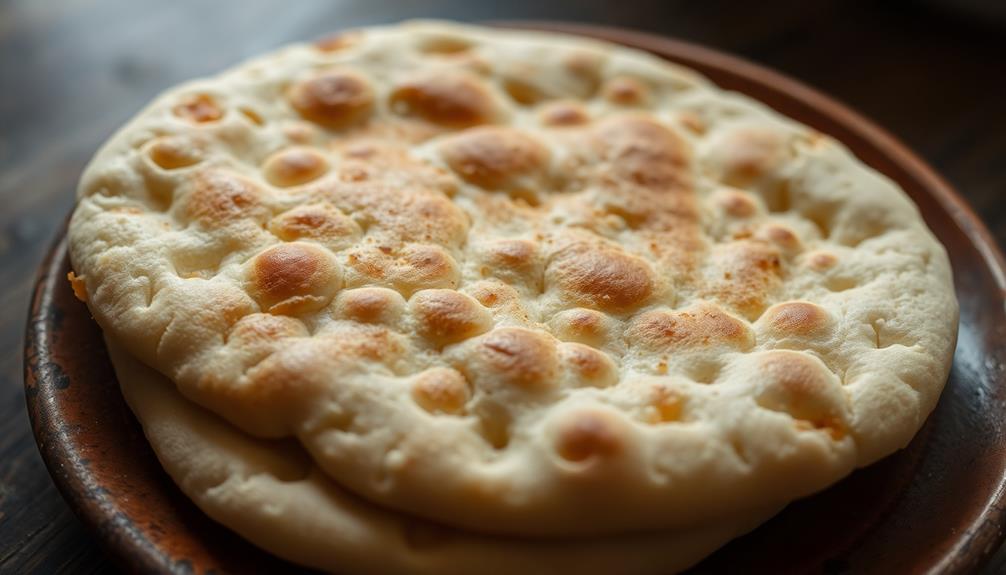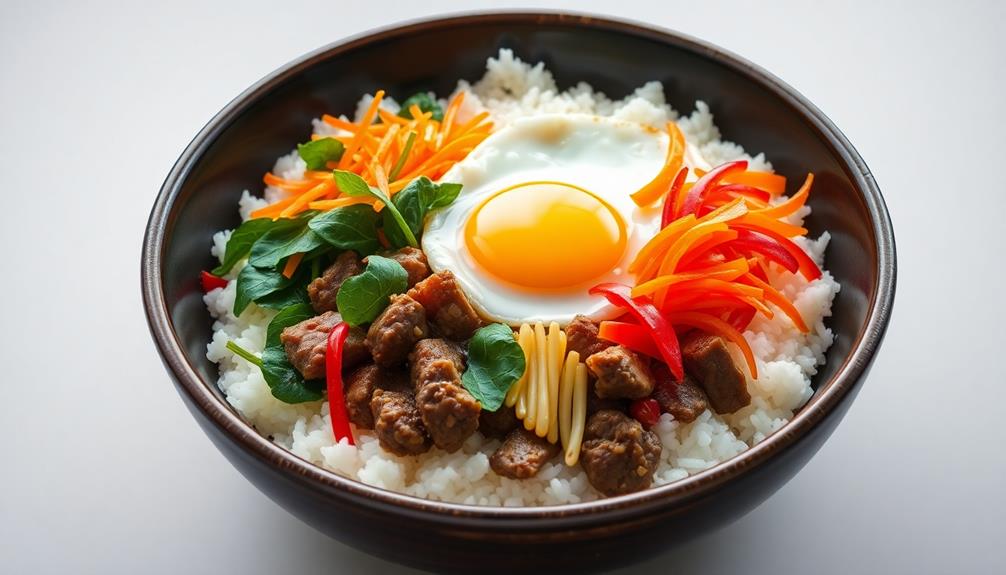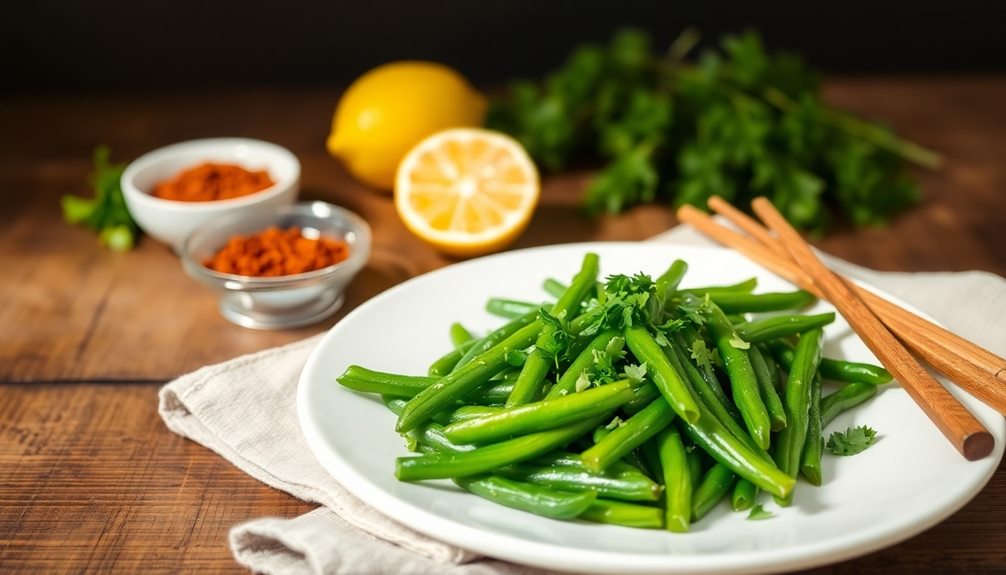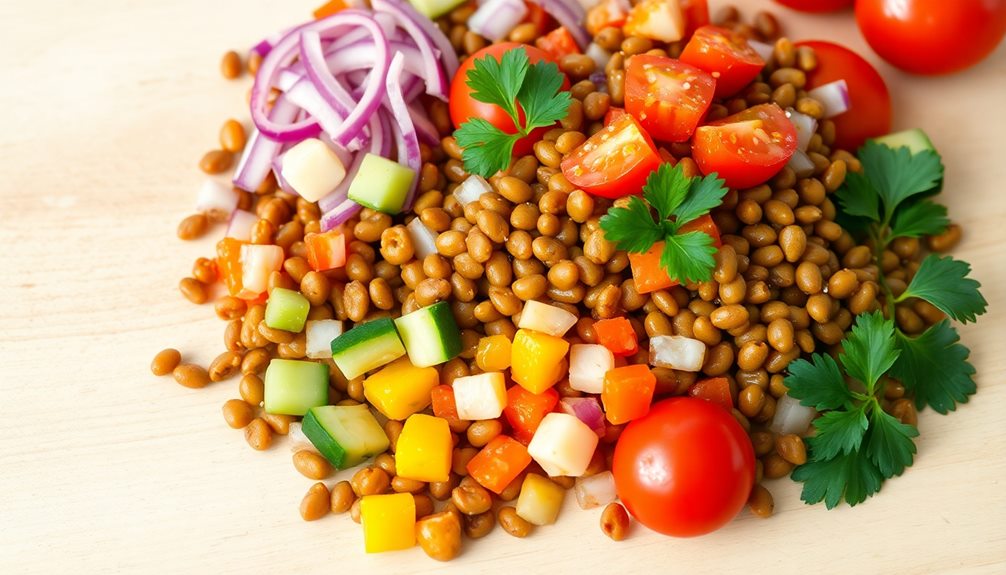Injera, the spongy and tangy sourdough flatbread, is a cornerstone of Ethiopian and Eritrean cuisine with a rich cultural heritage dating back centuries. You'll create this traditional staple by mixing teff flour, water, and a sourdough starter, then letting the batter ferment for 1-2 days to develop its signature sour flavor. Cooking it on a griddle results in a light, spongy texture that's perfect for scooping up rich stews. Injera isn't just a bread – it's a beloved part of cultural celebrations, bringing a sense of community to mealtimes. And if you keep reading, you'll uncover even more fascinating details about this unique flatbread.
Key Takeaways
- Injera is a traditional sourdough flatbread that originated in Ethiopia and Eritrea, with roots dating back to the 4th century AD.
- The recipe for injera requires specific ingredients like teff flour, water, salt, and a sourdough starter, which undergoes a 1-2 day fermentation process.
- The preparation and cooking process involves mixing the batter, allowing it to ferment, and then cooking it on a preheated griddle until the edges are dry and lifted.
- Injera is known for its unique spongy texture and distinctive sour flavor, making it a perfect accompaniment to various stews and sauces in Ethiopian cuisine.
- Injera has gained popularity beyond its cultural roots, inspiring variations and adaptations in international cuisines and highlighting the importance of traditional foods worldwide.
History
Originating in Ethiopia and Eritrea, injera has a rich history dating back thousands of years. This traditional sourdough flatbread has long been a staple in the diets of these regions, with evidence of its existence since the 4th century AD.
Over the centuries, the production and preparation of injera have evolved, reflecting the ingenuity and culinary traditions of the local people.
Traditionally, injera was made by fermenting a batter of teff flour, water, and a starter culture, allowing the natural yeasts to leaven the bread. This fermentation process not only gives injera its distinctive sour flavor but also enhances its nutritional profile, making it a healthier alternative to other breads.
Today, injera remains an integral part of many cultural celebrations and everyday meals throughout the Horn of Africa, showcasing the enduring legacy of this ancient sourdough flatbread.
Recipe
Injera, the traditional sourdough flatbread of Ethiopia and Eritrea, is a staple in the cuisines of these regions. This spongy, slightly tangy bread is the foundation for many dishes and is often used to scoop up stews and sauces. The unique flavor and texture of injera come from the fermentation process, which can take several days to complete.
To make authentic injera, you'll need to start with a sourdough starter, which is a living culture of wild yeasts and bacteria. This starter is combined with teff flour, the tiny, gluten-free grain that gives injera its distinct flavor and appearance. The batter is left to ferment for a day or more, allowing the flavors to develop before being cooked into thin, crepe-like rounds.
Ingredients:
- 2 cups teff flour
- 2 cups water
- 1 teaspoon salt
- 1 cup sourdough starter
Instructions: In a large bowl, whisk together the teff flour, water, salt, and sourdough starter until the batter is smooth and free of lumps. Cover the bowl and let the batter ferment at room temperature for 24-48 hours, until it has a slightly sour aroma and has risen slightly.
Heat a large, non-stick skillet over medium heat. Pour a thin layer of batter (about 1/4 cup) onto the hot pan and cook for 2-3 minutes, until the edges are dry and the center is just set. Flip and cook for another 1-2 minutes on the other side. Repeat with the remaining batter, stacking the cooked injera on a plate as you go.
When cooking injera, you'll want to work quickly to ensure the batter doesn't sit too long on the hot pan, as this can cause it to become dry and brittle. Additionally, it's important to use a non-stick surface, as the batter can be quite delicate.
With a little practice, you'll be able to produce those perfect, spongy rounds of injera to serve alongside your favorite Ethiopian dishes.
Cooking Steps
To begin, mix the teff flour and water until you've got a smooth batter.
Then, let this ferment for several hours or even overnight to develop that signature sour flavor.
When you're ready to cook, preheat your griddle and gently pour the batter onto it, flipping the injera carefully once it's cooked through.
Step 1. Mix Teff Flour and Water

With teff flour and water at the ready, begin by combining the two in a large mixing bowl.
Use a wooden spoon to stir the mixture until it forms a smooth, slightly runny batter. It should have a consistency similar to pancake batter.
Add more water if the batter is too thick, or more teff flour if it's too thin.
Stir the batter vigorously for about 5 minutes, ensuring there are no lumps. This helps activate the natural yeast in the teff, which is crucial for the sourdough flavor.
Cover the bowl with a damp towel and let the batter rest for at least 12 hours, or up to 24 hours, at room temperature. This fermentation process is what gives injera its distinctive sour taste.
After the resting period, the batter should have expanded and developed bubbles on the surface, indicating it's ready to cook.
Give it a gentle stir before ladling it onto a heated pan or griddle.
With a little practice, you'll be making delicious, authentic injera in no time!
Step 2. Let the Batter Ferment
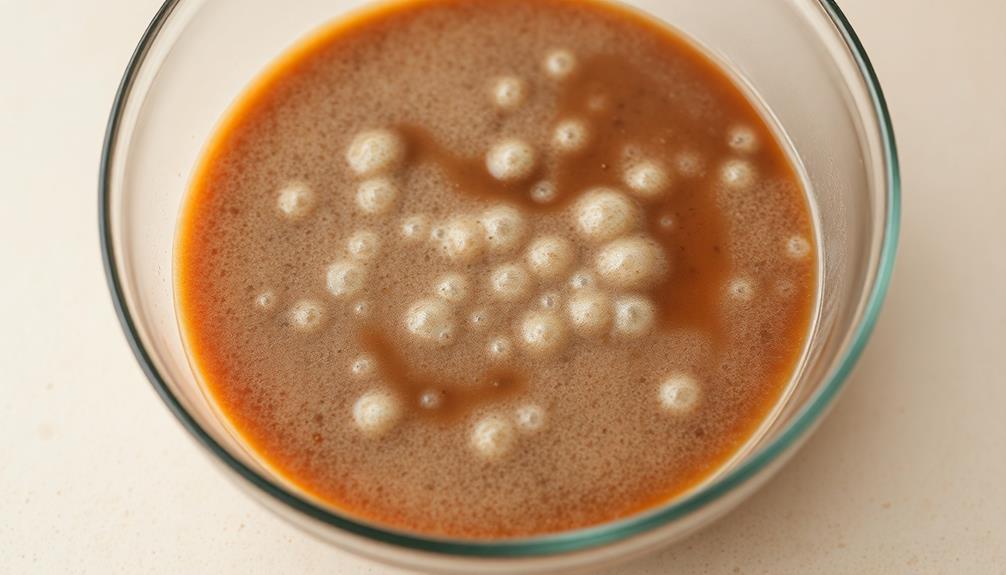
Now that you've mixed the teff flour and water, it's time to let the batter ferment. This fermentation process is crucial for creating the signature spongy and slightly tangy flavor of injera.
Cover the bowl with a clean towel and let it sit at room temperature for 12-24 hours. As the batter ferments, it'll become more bubbly and sour-smelling. Resist the urge to peek too often, as this can slow down the fermentation.
Once the batter has doubled in size and has a pleasantly sour aroma, it's ready to use.
Gently stir the batter to incorporate any liquid that may have separated on top. Be careful not to overmix, as this can deflate the batter.
Now you can start cooking your injera! The fermented batter will create the perfect texture and flavor for your traditional Ethiopian flatbread.
Step 3. Cook on Preheated Griddle
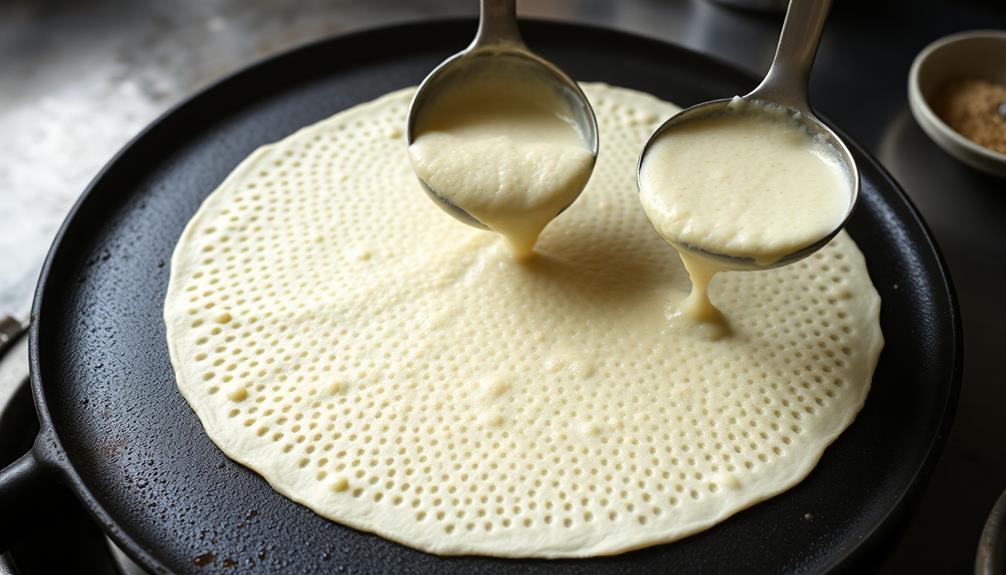
Once your batter has finished fermenting, it's time to start cooking your injera. Prepare a large, flat skillet or griddle and heat it over medium-high heat until it's nice and hot. You'll want to make sure the surface is evenly heated, as this will help your injera cook up nice and evenly.
Now, take a ladle and scoop up some of the fermented batter, pouring it gently onto the center of the hot griddle. Use the back of the ladle to quickly spread the batter out into a thin, round shape, creating a traditional injera flatbread.
Cook the injera for about 2-3 minutes, or until the edges start to dry out and lift up from the surface. Once it's cooked through, gently remove the injera from the griddle and place it on a plate or clean surface to cool.
Repeat this process, ladling and spreading the batter, until you've used up all of your fermented mixture. Serve your fresh, homemade injera warm, and enjoy!
Step 4. Flip the Injera Gently

Careful flipping motions are crucial when cooking the injera. Gently slide a spatula underneath the flatbread, taking care not to tear the delicate texture. Slowly lift the injera, then quickly flip it over onto the preheated griddle. This gentle movement helps maintain the light, spongy structure of the sourdough bread.
As the injera cooks, you'll notice tiny holes and cavities forming on the surface. This is a good sign – it means the bread is cooking properly. Keep a close eye on the underside, flipping the injera again when it's lightly browned, usually after 1-2 minutes.
Continue this process, flipping the bread every couple of minutes, until it's fully cooked through. Remember to handle the injera with care, as it can tear easily.
With a little practice, you'll be flipping these traditional Ethiopian flatbreads with ease, creating the perfect canvas for your favorite stews and dishes.
Step 5. Remove Injera From Griddle
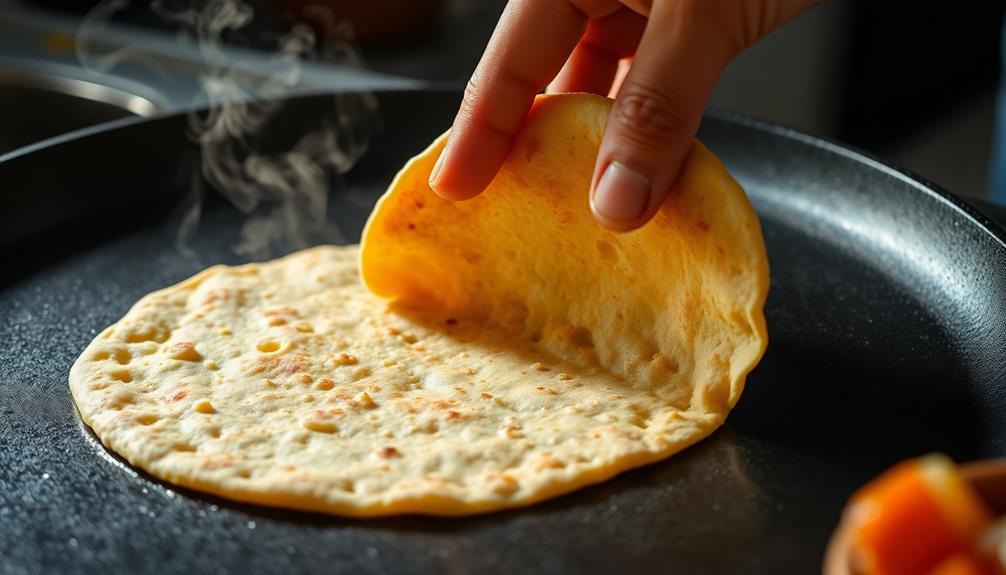
When the injera is lightly browned on the second side, it's time to remove it from the griddle. Gently slide a spatula under the injera, lifting it from the hot surface. Be careful not to tear the delicate bread.
Lift the injera and transfer it to a clean, flat surface, such as a plate or a large platter.
Arrange the injera in a stack, placing a clean, damp towel between each layer to prevent them from sticking together. This will help maintain the injera's soft, pliable texture. As you remove more injera from the griddle, continue building the stack, using the towel to separate the layers.
Once all the injera has been removed, cover the stack with the damp towel to keep the bread moist until ready to serve. This simple step ensures the injera remains fresh and ready to enjoy with your favorite Ethiopian dishes.
Final Thoughts
Injera, the quintessential Ethiopian sourdough flatbread, has captivated hearts and stomachs alike. As you've now mastered the art of removing this delightful creation from the griddle, it's time to reflect on the journey. Moving forward, you may find yourself wanting to expand your Ethiopian culinary skills beyond injera. Luckily, the next step in your gastronomic adventure is learning how to make chechebsa, a traditional Ethiopian dish made from shredded flatbread. With the same dedication and patience you put into perfecting your injera, you can now dive into the world of chechebsa and continue to impress your taste buds and those of your friends and family.
Injera's unique flavor and texture make it a cherished staple, not just in Ethiopia, but across the world. Its spongy goodness pairs perfectly with a variety of stews and sauces, creating a harmonious dining experience.
Though the process may seem daunting at first, with a little practice, you'll be whipping up batches of injera with ease. The reward of serving this traditional bread to family and friends is truly unmatched.
Whether enjoyed in a formal setting or as a casual snack, injera always brings a sense of community and cultural celebration.
As you continue to explore the wonders of this sourdough delight, remember to savor each bite and embrace the joy of this timeless culinary tradition.
Frequently Asked Questions
Is Injera Gluten-Free?
You'll be glad to know that injera is typically gluten-free. It's made from teff flour, a naturally gluten-free grain, so it's a great option for those with gluten intolerances or celiac disease.
How Long Does Injera Take to Ferment?
Typically, the fermentation process for injera takes around 3-5 days. The longer you let it ferment, the more sour and tangy the flavor will become. Be patient, as the lengthy fermentation is crucial for achieving the perfect injera texture.
Can Injera Be Stored for Later Use?
Yes, you can store injera for later use. Once fermented, you can refrigerate or freeze the injera to enjoy it later. Just be sure to reheat it properly before serving.
What Are the Main Ingredients in Injera?
The main ingredients in injera are teff flour, water, and a sourdough starter. You'll need these staple items to create the classic Ethiopian flatbread with its spongy, slightly tangy texture.
How Do I Reheat Leftover Injera?
To reheat leftover injera, you can place it on a damp paper towel and microwave it in 30-second intervals until heated through. Alternatively, you can wrap it in foil and warm it in the oven at a low temperature.
